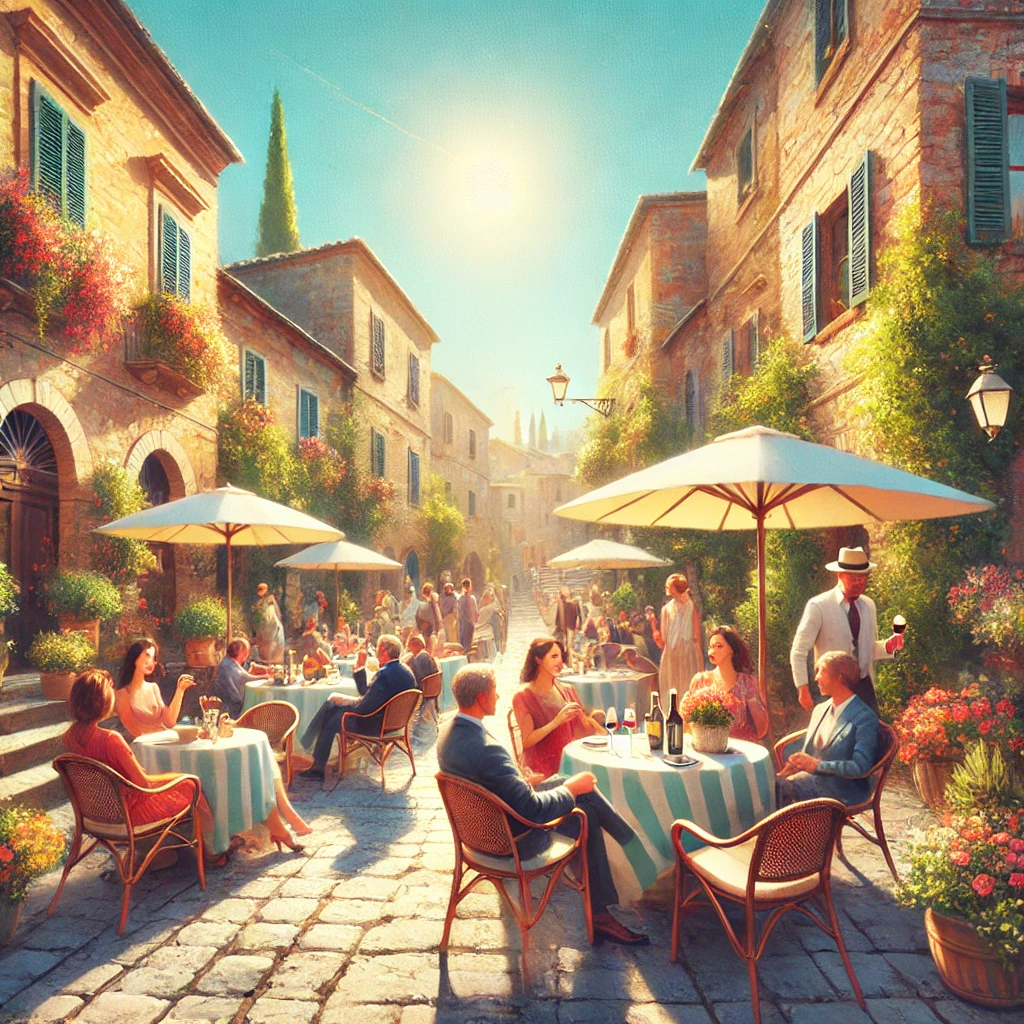Table of Contents
Understanding La Dolce Vita
‘La Dolce Vita,’ which translates to ‘the sweet life,’ is a phrase that encapsulates an Italian way of living, reflecting a deep appreciation for the pleasures and joy that life can offer. Its origins can be traced back to Italy’s post-war era, particularly the 1960s, a time marked by significant social, cultural, and economic transformation. During this period, Italians sought not just survival but a newfound enjoyment of life that embraced leisure, beauty, and flavorful experiences, signifying a shift from mere existence to a celebration of life’s offerings.
The cultural tapestry of Italy is interwoven with the values of ‘La Dolce Vita,’ where the importance of taking joy in everyday activities comes to the forefront. Italians are known for their leisurely meals, where food becomes a communal bond rather than just sustenance. The act of dining transforms into an art form, reflective of the broader Italian philosophy that emphasizes savoring moments rather than rushing through them. This approach extends beyond mealtime, infiltrating social gatherings, family interactions, and various other aspects of daily life.
Furthermore, the principles underscoring ‘La Dolce Vita’ involve a balance between work and leisure. Italians are often recognized for their ability to embrace relaxation, with afternoons devoted to rest and social interactions. The societal emphasis on pleasure illustrates a holistic understanding of well-being that cherishes both the personal and communal experiences. ‘La Dolce Vita’ is not merely a nostalgic concept but a living testament to the values of enjoyment, relationships, and the art of living fully.
In essence, the Italian approach to living well, as embodied in ‘La Dolce Vita,’ encourages individuals to appreciate the beauty surrounding them, prioritize meaningful connections, and immerse themselves in the richness of life’s simple pleasures.

The Importance of Family and Community
The Italian culture places a profound emphasis on the importance of family and community, which serve as foundational pillars in the collective approach to well-being. In Italy, familial bonds transcend mere relationships; they embody a network of support that is integral to daily life. This interconnectedness fosters resilience, emotional stability, and a sense of belonging among individuals. Italian families often prioritize time spent together, regularly gathering for meals and celebrations, a practice that reinforces these bonds and nurtures shared experiences.
Communal meals are a notable tradition in Italian society, where the act of sharing food transforms into a significant ritual promoting togetherness. Families often convene around the dining table, not only to enjoy their culinary heritage but also to engage in lively conversations. This communal aspect of dining cultivates connections among family members, allowing for the exchange of stories, values, and support. It becomes a setting where joy is expressed, and challenges are shared, contributing to an individual’s overall well-being.
In addition to family ties, the sense of community within Italian culture plays a crucial role in nurturing a supportive environment. Local festivals, cultural events, and communal gatherings reinforce social bonds among neighbors and friends, enhancing mutual respect and collaboration. These gatherings allow individuals to participate in shared traditions, creating a collective identity that enhances one’s sense of belonging. As residents come together to celebrate milestones and provide support during hardships, they fortify the social fabric that characterizes Italian life.
Moreover, the engagement with community not only fosters relationships but also encourages a lifestyle attuned to collective well-being. With family and community entities working hand in hand, the Italian emphasis on interconnectedness acts as a powerful driver for happiness and fulfillment in everyday life.
Savoring Food and Drink
The Italian approach to food is deeply ingrained in the culture, where meals are considered celebrations rather than mere tasks to be completed. The philosophy of “La Dolce Vita” extends profoundly to the eating and drinking experience, emphasizing the importance of savoring every bite and sip. This notion fosters a lifestyle in which food is not rushed; instead, it is enjoyed, appreciated, and central to social gatherings.
One of the key elements of the Italian culinary art is the commitment to seasonal and local produce. Italians take pride in sourcing ingredients from their regional markets, ensuring that meals are prepared with the freshest offerings available. This practice not only enhances the flavor and nutritional value of the dishes but also supports local farmers and contributes to the sustainability of food practices. The focus on seasonal ingredients often leads to innovative recipes and traditional dishes that celebrate the unique character of each region.
Traditional cooking techniques play a significant role in Italian cuisine. Many families pass down age-old recipes through generations, maintaining methods that connect contemporary meals with their historical roots. Techniques such as slow-cooking, roasting, and hand-rolling pasta require time, patience, and a certain level of artistry, which encourages a deeper connection to the food being prepared. Furthermore, dining often becomes a communal experience where families and friends gather to share plates, stories, and laughter, reinforcing bonds through food.
Each Italian region boasts its own specialties, resulting in diverse flavors that reflect local traditions and customs. From the rich ragu of Emilia-Romagna to the seafood dishes of Sicily, regional differences add a layer of excitement to the Italian dining experience. Ultimately, the Italian way of enjoying food and drink offers a blueprint for cultivating mindfulness and appreciation in everyday life, providing valuable lessons in how meals can nourish not just the body but also the soul.
Embracing Simplicity and Quality
The Italian philosophy of ‘la bellezza della semplicità,’ or the beauty of simplicity, significantly influences lifestyle choices and material possessions throughout the country. This approach emphasizes a preference for quality over quantity, demonstrating a profound appreciation for the finer aspects of life. Italians often embrace a more minimalist approach to their belongings, choosing to invest in fewer high-quality items that offer both functionality and aesthetic appeal.
In everyday life, this commitment to simplicity can be observed in various facets of Italian culture, including fashion, home decor, and culinary practices. When it comes to clothing, for instance, many Italians opt for timeless, elegant pieces instead of following fleeting fashion trends. This not only fosters a sense of individuality but also promotes a sustainable approach to consumerism. Investing in well-crafted garments allows individuals to enjoy their possessions for many years, thereby reducing waste and promoting mindful consumption.
The relationship that Italians have with craftsmanship is particularly striking. There exists a deep admiration for handmade goods, stemming from a recognition of the effort, time, and skill that goes into their creation. This reverence for artisans is evident in various sectors, from leather goods in Florence to ceramics in the Amalfi Coast. Consumers are often willing to pay a premium for these items, understanding that they carry intrinsic value beyond mere materiality. Such an investment not only supports local artisans but also encourages the preservation of traditional crafts and techniques.
Furthermore, this focus on quality enhances everyday experiences, elevating the simple pleasures of life. Whether it is enjoying a well-prepared meal or investing in exquisite tableware, Italians embody the principle that life’s richness lies in appreciating the beautifully crafted elements that surround them.
The Art of Leisure and Relaxation
In Italian culture, leisure and relaxation are integral components of a balanced, fulfilling lifestyle. Unlike certain cultures where work often takes precedence over all else, Italians embrace the concept of ‘la dolce vita,’ or the sweet life, emphasizing the importance of taking time to enjoy the simple pleasures. One prominent tradition illustrating this philosophy is the ‘passeggiata,’ an evening stroll that serves not only as physical exercise but also as a social activity. This leisurely walk through town promotes engagement with friends and family, strengthens community bonds, and allows for reflection on the day’s events.
Another aspect of the Italian approach to wellbeing is the cultural significance placed on time spent for oneself. Italians generally prioritize their own needs, unapologetically carving out moments during the day for relaxation. Whether sipping a cup of espresso at a local café or indulging in a leisurely meal with loved ones, these practices create opportunities to unwind and recharge. This perspective fosters a healthier work-life balance, in which personal contentment is regarded as paramount in both daily life and long-term aspirations.
Moreover, Italians have cultivated various practices aimed at promoting relaxation throughout the day. For instance, many embrace the tradition of taking breaks known as ‘pausa,’ which are often observed in the early afternoon. During this time, it is common to pause work and enjoy a light meal, rest, or engage in conversation. This practice not only re-energizes the mind and body but also enhances productivity when returning to tasks. By integrating relaxation into their daily routines, Italians effectively mitigate stress and promote overall wellness. Ultimately, the emphasis on leisure and relaxation reflects the Italian belief that a life well-lived is one marked by enjoyment, balance, and connection.
Connection with Nature
In Italy, the connection with nature is a fundamental aspect of life, intricately woven into the fabric of the culture. The country’s diverse landscapes—ranging from the rolling hills of Tuscany to the stunning coastlines of the Amalfi Coast—play a crucial role in shaping the Italian way of living. Italians often prioritize time spent outdoors, fostering a deep appreciation for their environment that contributes greatly to their overall quality of life.
This relationship with nature is manifested in numerous cultural activities that invite engagement with the physical world. For instance, vineyard tours allow individuals to immerse themselves in the beauty of lush vineyards while learning about the intricate processes of winemaking. Such experiences not only celebrate the natural landscape of Italy but also promote mindfulness and a slower pace of life, encouraging individuals to savor their surroundings.
Outdoor markets are another significant cultural phenomenon that exemplify this connection. These vibrant gatherings enable locals and visitors alike to experience the sights, sounds, and smells of fresh produce, artisanal foods, and handmade goods. By patronizing local vendors, residents engage in a relationship with nature that extends beyond mere appreciation; it becomes a celebration of the land’s abundance and the community’s shared livelihood. Furthermore, spending time in these open-air markets fosters social cohesion, with community members forging bonds over shared goods and culinary delights.
The Italians’ engagement with nature is not just a cultural preference; it is a lifestyle choice that reflects their values. By prioritizing time outdoors in stunning environments and participating in activities that honor the natural world, Italians embrace a holistic approach to living well—embracing la dolce vita in its purest form. Connecting with nature enriches daily life, enhancing well-being and reminding individuals of the beauty that surrounds them.
Cultural Heritage and Artistic Expression
Italy’s rich cultural heritage plays a crucial role in shaping the lifestyle of its residents. From the majestic architecture that lines its historic cities to the vibrant art and music that permeate daily life, the Italian approach to living well is intricately woven into the fabric of cultural expression. This artistic legacy is not merely a reflection of the past; instead, it is a vibrant, evolving force that influences contemporary society.
Art in Italy extends beyond museum walls; it is evident in the way individuals engage with their surroundings. Public squares, for example, often serve as stages for aspiring musicians, dancers, and artists, fostering an environment where creativity can flourish. This engagement with art fosters a sense of community, as people come together to share experiences and celebrate local talents. Such activities enhance communal ties, making individuals feel more connected to their neighborhoods and fellow citizens.
Music is another pillar of Italian culture that significantly influences residents’ lifestyles. Whether through traditional folk songs, operatic performances, or modern pop music, soundscapes in Italy are diverse and deeply appreciated. Festivals celebrating musical heritage not only revive historical traditions but also encourage collective joy and participation. These events bring people together, creating a sense of unity and belonging that is exceptionally valuable in today’s fast-paced world.
Fashion, which often originates from Italy’s renowned design houses, is also an essential part of daily life. The Italian flair for style promotes self-expression and contributes to a sense of identity and pride. When individuals dress thoughtfully, they convey a respect for their cultural roots while adapting to modern influences. This blend of history and contemporary trends exemplifies how cultural heritage continues to shape individual and collective identities.
Mindfulness and Gratitude
In Italy, the principles of mindfulness and gratitude are deeply interwoven into daily life, shaping the Italian approach to living well. This emphasis on mindfulness encourages individuals to reflect on and appreciate life’s simple pleasures, fostering a profound sense of gratitude that permeates various aspects of their existence. Integral to this practice is the value placed on daily rituals, which promote a strong connection to the present moment.
Italians often partake in traditions that emphasize being present and fully engaged in their experiences. For instance, the daily ritual of enjoying a freshly brewed espresso not only serves as a moment of pause but also as an opportunity to savor the rich flavors and aromas, engaging their senses. This act of mindful enjoyment transcends mere consumption; it is a celebration of simplicity that invites gratitude for the small joys in life. Additionally, communal meals with family and friends are common, allowing for meaningful conversations and shared moments that reinforce connections, bringing a collective sense of gratitude for relationships and shared experiences.
Moreover, seasons and local festivals play a vital role in cultivating mindfulness. Celebrating traditional festivals, such as harvest seasons or local fairs, enables individuals to reconnect with their surroundings and appreciate the beauty of nature and community. These events foster a sense of belonging and highlight the significance of cherishing memories and experiences, be they grand or modest.
Ultimately, the Italian practice of mindfulness and gratitude encourages a lifestyle where individuals are urged to take a moment, reflect on their surroundings, and acknowledge the blessings in their lives. By embracing this approach, one can cultivate a deeper appreciation for both the fleeting moments of joy and the grandeur of life itself.
Lessons for a Fulfilling Life
The Italian way of living, often encapsulated in the phrase “La Dolce Vita,” offers a wealth of wisdom that can greatly enhance our daily lives. Central to this philosophy is the emphasis on enjoyment and appreciation of life’s small pleasures. Embracing a mindset that values joy can transform mundane moments into cherished experiences. Italians have a unique ability to savor their meals, time with loved ones, and nature, encouraging us to slow down and celebrate life daily. This practice can lead to increased happiness and satisfaction in our fast-paced world.
Another important lesson from the Italian approach is the significance of fostering meaningful connections. Italians place great importance on family and friendships, often prioritizing these relationships above all else. By nurturing our social circles and investing time in relationships, we can create a support system that enriches our lives and contributes to our overall well-being. Regular gatherings with family and friends not only strengthen bonds but also enhance our sense of belonging and community.

Quality over quantity is a principle that permeates Italian culture. Whether selecting a meal, a piece of clothing, or an experience, Italians tend to value high-quality options that bring genuine satisfaction rather than a multitude of lesser choices. This perspective encourages us to be intentional about what we consume, both materially and experientially. By focusing on quality, we can derive greater pleasure and fulfillment from the everyday items and experiences in our lives.
Finally, being present in the moment is a crucial aspect of the Italian lifestyle. This mindfulness allows individuals to fully appreciate their surroundings and experiences, promoting a sense of peace and contentment. By practicing mindfulness, we can cultivate a deeper appreciation for life, encouraging us to find beauty in simplicity. Adopting these lessons from “La Dolce Vita” can guide us toward a more fulfilling and enriching life.






Wohh exactly what I was searching for, appreciate it for putting up.